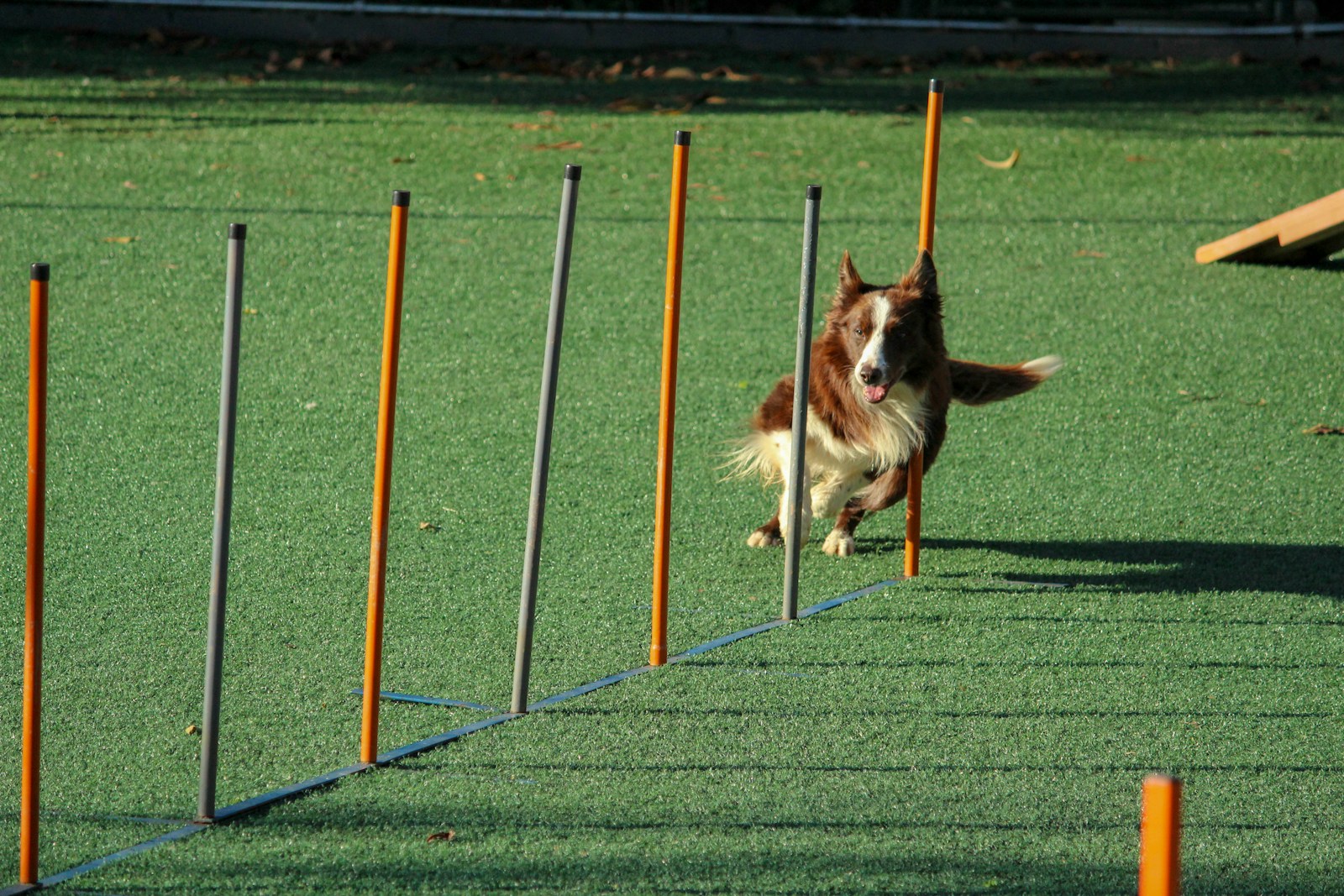Keeping your dog mentally stimulated is just as important as physical exercise.
Brain training activities help prevent boredom, reduce anxiety, and improve your dog’s overall behavior and well-being. Here are 10 effective ways to challenge your dog’s mind and keep them engaged.
Table of Contents
1. Teach New Tricks: Unlock Your Dog’s Full Potential
Teaching your dog new tricks is one of the best ways to engage their brain while strengthening your bond. Dogs are naturally curious and love mental challenges, making trick training both fun and rewarding. Here’s how you can get started and progress:
1. Start with Simple Commands
Begin with basic tricks that are easy to learn and build confidence in your dog. For example:
- Shake: Hold a treat in your hand and encourage your dog to lift their paw. Once they touch your hand, reward them with the treat and praise.
- Roll Over: Use a treat to guide your dog into a lying position, then slowly move the treat in a circular motion over their shoulder to encourage them to roll.
2. Incorporate More Complex Tricks
Once your dog masters the basics, challenge them with more advanced tricks. Examples include:
- Fetch a Specific Toy: Teach your dog to recognize toys by name. Start with one toy, saying its name while pointing to it. Reward them when they bring it to you, then add more toys for variety.
- Put Toys Away: Train your dog to clean up after playtime by dropping toys into a basket. Use a command like “clean up” and reward them for each successful attempt.
3. Make It Fun and Rewarding
Positive reinforcement is key to successful trick training. Use treats, praise, or a favorite toy to motivate your dog and celebrate their progress. Keep training sessions short (5–10 minutes) to maintain their focus and prevent frustration.
Pro Tip:
Use positive reinforcement techniques, such as treats or verbal praise, to make learning fun and rewarding.
2. Interactive Puzzle Toys
Interactive puzzle toys are excellent tools to challenge your dog’s brain and keep them entertained. These toys are designed to make your dog work for their reward, often by solving problems to access hidden treats or food.
Benefits of Puzzle Toys
- Mental Stimulation: Puzzle toys encourage your dog to think critically and stay mentally active, reducing boredom and the likelihood of destructive behavior.
- Slower Eating: Some puzzles double as slow feeders, helping to pace your dog’s eating and prevent digestive issues.
- Problem-Solving Skills: These toys sharpen your dog’s ability to focus and solve problems, which can improve their overall behavior and responsiveness.
Types of Puzzle Toys
- Treat-Dispensing Balls: Your dog has to roll or nudge the ball to release treats, keeping them engaged for longer.
- Sliding or Flip Board Puzzles: These require your dog to move pieces with their nose or paws to reveal hidden rewards.
- Snuffle Mats: Mimicking the act of foraging, these mats let your dog sniff out treats hidden in fabric folds, catering to their instincts.
Tips for Introducing Puzzle Toys
- Start Simple: Choose beginner-level toys to avoid frustration, then gradually introduce more complex designs as your dog becomes confident.
- Supervise Initially: Watch your dog as they explore the toy to ensure they interact with it safely and understands how it works.
- Rotate Toys: Keep things fresh by rotating different puzzle toys to maintain your dog’s interest.
Suggestions:
- Snuffle mats
- Treat-dispensing balls
- Sliding puzzle boards
3. Play Hide and Seek
Hide and seek isn’t just for kids—it’s a fun and engaging game for dogs, too! This activity taps into their natural hunting instincts, provides mental stimulation, and strengthens your bond. Here’s how to play:
How to Play Hide and Seek with Your Dog
- Start Simple: Begin by having your dog sit and stay in one room while you hide nearby. If your dog is new to the game, make it easy by hiding in plain sight or behind furniture.
- Call Their Name: Once you’re hidden, call your dog’s name or use a release command like “Find me!” Encourage them to search until they locate you.
- Reward Them: When your dog finds you, shower them with praise, treats, or their favorite toy to reinforce their success.
Benefits of Hide and Seek
- Mental and Physical Stimulation: The game exercises both your dog’s brain and body as they sniff, search, and move around.
- Improved Recall: Repeatedly calling their name during the game reinforces their recall skills in a fun, low-pressure way.
- Strengthened Bond: Playing hide and seek builds trust and deepens your relationship by engaging in an interactive activity together.
Hide and Seek is a simple, low-cost game that provides endless entertainment for both you and your dog while keeping their mind sharp. Give it a try and watch their tail wag with excitement!
Advanced Tip:
Incorporate scent training by hiding treats instead of yourself.
4. DIY Obstacle Course
Building a DIY obstacle course at home is a fantastic way to provide your dog with physical exercise and mental stimulation. It’s an engaging activity that challenges their coordination, focus, and problem-solving skills while being fun for both of you.
How to Create a DIY Obstacle Course
- Use Everyday Items: Gather household items like chairs, cushions, broomsticks, boxes, and hula hoops. These are perfect for creating safe and creative obstacles.
- Tunnels: Drape a blanket over two chairs or use a large cardboard box to create a tunnel for your dog to crawl through.
- Hurdles: Place a broomstick across two sturdy supports for your dog to jump over. Adjust the height based on your dog’s size and ability.
- Weave Poles: Line up a series of upright objects (like cones, books, or water bottles) for your dog to weave through.
- Balance Challenges: Use a sturdy plank on the ground or a cushion for your dog to walk across carefully.
- Guide Your Dog: Lead your dog through the course using treats, a favorite toy, or verbal encouragement. Start slowly and praise them for each successful attempt.
- Increase the Challenge: As your dog becomes more confident, rearrange the obstacles, add new elements, or time them to make the activity more exciting and challenging.
Benefits of a DIY Obstacle Course
- Physical Exercise: Navigating the course keeps your dog active, promoting better health.
- Mental Stimulation: Figuring out how to tackle each obstacle sharpens their problem-solving skills.
- Confidence Building: Completing the course boosts your dog’s confidence as they master new challenges.
- Strengthened Bond: Working together on the course deepens trust and strengthens your connection.
A DIY obstacle course is a cost-effective and customizable activity that suits dogs of all ages and energy levels. It’s a great way to keep your pup engaged and happy indoors or in the backyard!
5. Rotate Toys
Dogs, like humans, can lose interest in items they see or use all the time. To keep them excited and engaged, rotating their toys is a simple and effective strategy that prevents boredom and stimulates curiosity.
How to Rotate Toys
- Sort Their Collection: Gather all your dog’s toys and divide them into groups. You can organize by type, such as chew toys, plush toys, or interactive puzzles.
- Limit Access: Offer only a small selection of toys at a time (2-3 options), and store the rest out of sight in a box or cupboard.
- Change Weekly: Every week or two, swap the current toys for a new set from storage. Your dog will be excited to “rediscover” toys they haven’t seen in a while.
To keep things fresh, include different types of toys in each rotation. For example, a squeaky toy, a puzzle toy, and a chew bone can provide a mix of textures and activities to stimulate your dog in different ways.
Benefits of Rotating Toys
- Mental Stimulation: New or forgotten toys rekindle curiosity and keep your dog engaged.
- Prevent Boredom: Regularly swapping toys reduces the likelihood of destructive behaviors caused by boredom.
- Cost-Effective: You don’t need to constantly buy new toys—rotating gives the illusion of novelty without extra expense.
By rotating toys, you create a fun and dynamic environment for your dog that keeps them happy, curious, and entertained!
6. Scent Work and Nose Games
Dogs naturally love using their incredible sense of smell, making scent work an excellent way to engage their minds. Start by hiding treats around your house or yard, encouraging your dog to sniff them out. Gradually increase the difficulty by hiding treats in harder-to-reach places or under objects.
Taking Scent Work to the Next Level
- Invest in scent work kits, which include special scent materials for advanced training.
- Use different scents like lavender, vanilla, or cinnamon to diversify the experience and challenge your dog’s nose.
This activity taps into your dog’s instincts, reduces boredom, and provides mental stimulation while keeping them entertained.
7. Play Tug-of-War
Tug-of-war is a fun physical game that mentally challenges your dog, especially when paired with impulse control training. Use a sturdy rope toy and let your dog tug while maintaining control of the game.
How to Make It Mentally Stimulating
- Teach the “release” command to encourage them to drop the toy when asked. This helps your dog focus and practice self-control.
- Alternate between tugging and giving commands like “sit” or “stay” to engage their brain during play.
Important Note: Keep the game friendly and playful. If your dog shows signs of aggression, stop the activity and redirect their energy.
8. Training with Hand Signals
Teaching your dog hand signals adds an extra layer of mental stimulation and improves their focus and responsiveness. It’s particularly helpful for reinforcing commands or communicating in noisy environments.
Examples of Hand Signals
- Pointing for “Sit”: Use a pointed finger or a quick upward motion to signal “sit.”
- Open Palm for “Stay”: Hold your palm out in a “stop” gesture to indicate “stay.”
- Sweeping Motion for “Down”: Use a downward sweeping motion to command your dog to lie down.
Pair these signals with verbal commands initially, then gradually phase out verbal cues as your dog learns to respond to hand gestures alone.
9. Learn Dog Sports
Engaging your dog in sports like agility, flyball, or canine freestyle dancing is a great way to keep their mind and body active. These activities challenge your dog’s coordination, speed, and focus while strengthening the bond between you and your pet.
Popular Dog Sports to Try
- Agility: Navigate through tunnels, weave poles, and jumps to enhance focus and physical fitness.
- Flyball: A fast-paced game where dogs retrieve a ball as part of a relay race.
- Canine Freestyle Dancing: Teach your dog choreographed moves set to music for a fun and creative activity.
Participation in dog sports not only keeps your dog sharp but also fosters teamwork and trust.
10. Practice Problem-Solving Activities
Problem-solving games are an excellent way to challenge your dog’s intelligence and encourage independent thinking. Start with simple activities like hiding a treat under one of three cups and shuffling them. Let your dog use their nose or paws to identify the correct cup.
Variations to Try
- Hide treats under cardboard boxes or bowls and let your dog figure out how to uncover them.
- Use puzzle toys or interactive feeders that require your dog to manipulate parts of the toy to access their reward.
These activities keep your dog mentally stimulated, reduce boredom, and provide an exciting way to bond through play.
Final Thoughts:
A mentally stimulated dog is a happier companion and a more well-behaved one. Keeping your dog’s mind engaged through brain training activities provides numerous benefits, from improving their obedience to reducing undesirable behaviors like excessive barking or chewing. Just like physical exercise, mental workouts are essential to your dog’s overall well-being.
Incorporating activities like scent work, puzzle games, or learning new tricks into your routine will not only challenge your cognitive abilities but also strengthen the bond you share. These exercises give your dog a sense of purpose, keep them occupied, and tap into their instincts, all while having fun.
Ultimately, the goal is to keep your dog’s tail wagging with excitement and provide them with a fulfilling, enriched life. With consistent mental stimulation, your dog will stay happy and thrive as a well-rounded, obedient, and joyful companion!
Develop your Dog’s “Hidden Intelligence” Get instant access






Pingback: 10 Fun and Engaging Ways to Play With Your Dog - Woofy Tips
Pingback: Copaiba, Krill Oil & DHA: 3 Powerful Supplements for a Dog